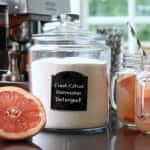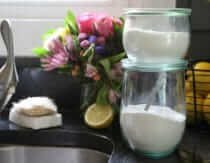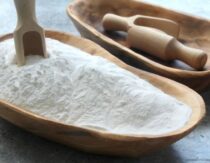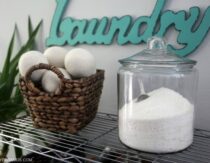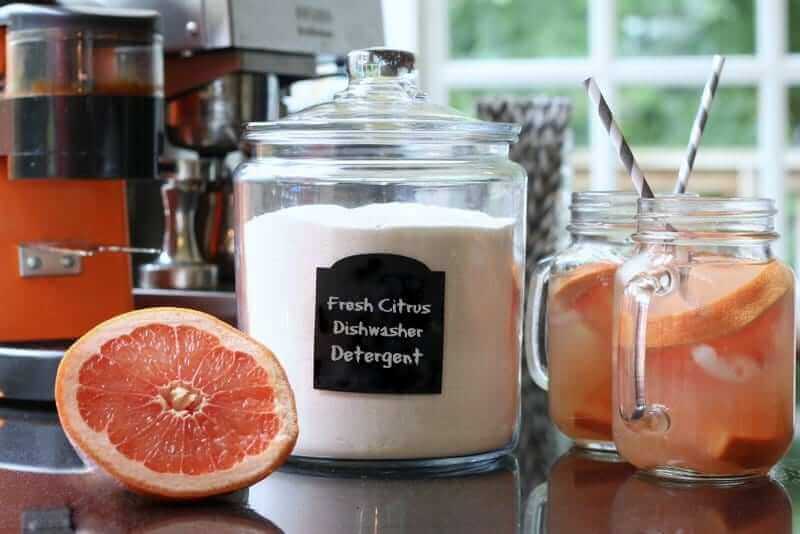
If you’ve ever tried making homemade dishwasher detergent and been disappointed with the results, chances are you were closer to a great recipe than you thought! Most do-it-yourself formulas use the same basic ingredients, but there’s a trick to getting natural cleaning recipes to work.
You see, cleansers like washing soda are considered a base, while buildup removers like citric acid are, well, an acid! While both of these components are essential to a good recipe, they neutralize each other if used at the same time. Many dishwasher detergent recipes mix them together, when really they’re best left separate.
Here’s an analogy: Hot water is soothing and relaxing, while cold water is refreshing and invigorating. However, when you mix the two together you end up with tepid water and lose the benefits of both.
So, what makes a good dishwasher detergent recipe?
Most commercial detergents use at least 50% washing soda in their formulas, with the remaining ingredients usually being water softeners and rinse aids.
Unfortunately, the extra ingredients in most popular detergents – this one, for example – get an “F” from the EWG for things like developmental and reproductive toxicity, respiratory concerns, environmental toxicity and carcinogenicity.
The chemicals don’t go away when our dishwater flows back to the municipal treatment plant, either. Many of them are not filtered out when the water is processed and sent back into our homes.
Companies use these problematic additives because they’re not acidic like most natural rinse aids, which means they don’t neutralize the washing soda. Fortunately, there’s a way to use washing soda without giving up a natural rinse aid, and that’s to introduce your cleanser and rinse aid during different points of the wash cycle so they don’t cancel each other out.
The detergent recipe below calls for pure washing soda as the primary cleansing agent, which should be followed by one or both of my natural rinse aid recipes.
Really, just washing soda?
If this is what you’re thinking, you’re not alone. Other homemade recipes contain ingredients like borax, kosher salt, epsom salt and baking soda, which can make them seem more legitimate somehow. Truth be told, though, all three of these ingredients do the same thing as washing soda – raise pH and soften water – just less effectively.
The only exception is borax, which in addition to helping raise pH also combines with washing soda to create hydrogen peroxide. However, you can get the same effect – only stronger – simply by using a natural oxygen bleach in your formula. This can be helpful if you’re still experiencing hard water deposits after using this detergent along with one or both of the rinse aids.
For instructions on adding oxygen bleach to your recipe, see the troubleshooting section at the bottom of this post.
What To Buy If You Don’t Want To DIY
I often get questions about what store-bought options I recommend for different products – even one-ingredient recipes like this one.
When I set out to find a store-bought alternative to this dishwasher detergent, I thought for sure the best option would be another powdered detergent. Turns out, though, that this liquid gel is one of the highest rated for both safety and performance.
For a rinse aid, Eco-Me is made with just four ingredients – vinegar, citric acid, coconut-derived soap and plant-derived solubilizer. The soap and stabilizer both score a “1” with the Environmental Working Group, which is the safest rating possible, and vinegar and citric acid are what I use in my homemade rinse aid.
Important: Read Before Transitioning To Homemade Dishwasher Soap
Before using this recipe for the first time, it’s important to clear away mineral deposits and/or other residue from your dishwasher. Otherwise, the citric acid may loosen them and then redeposit them on your dishes.
To prepare your dishwasher, place 1/4- 1/2 cup citric acid in the bottom of your empty dishwasher and start a cycle. Allow it to run for 3-5 minutes and then turn the dishwasher off.
Let the water/citric acid solution soak for 3-4 hours and then allow the cycle to complete. Your dishwasher is now ready to run its first homemade detergent cycle!
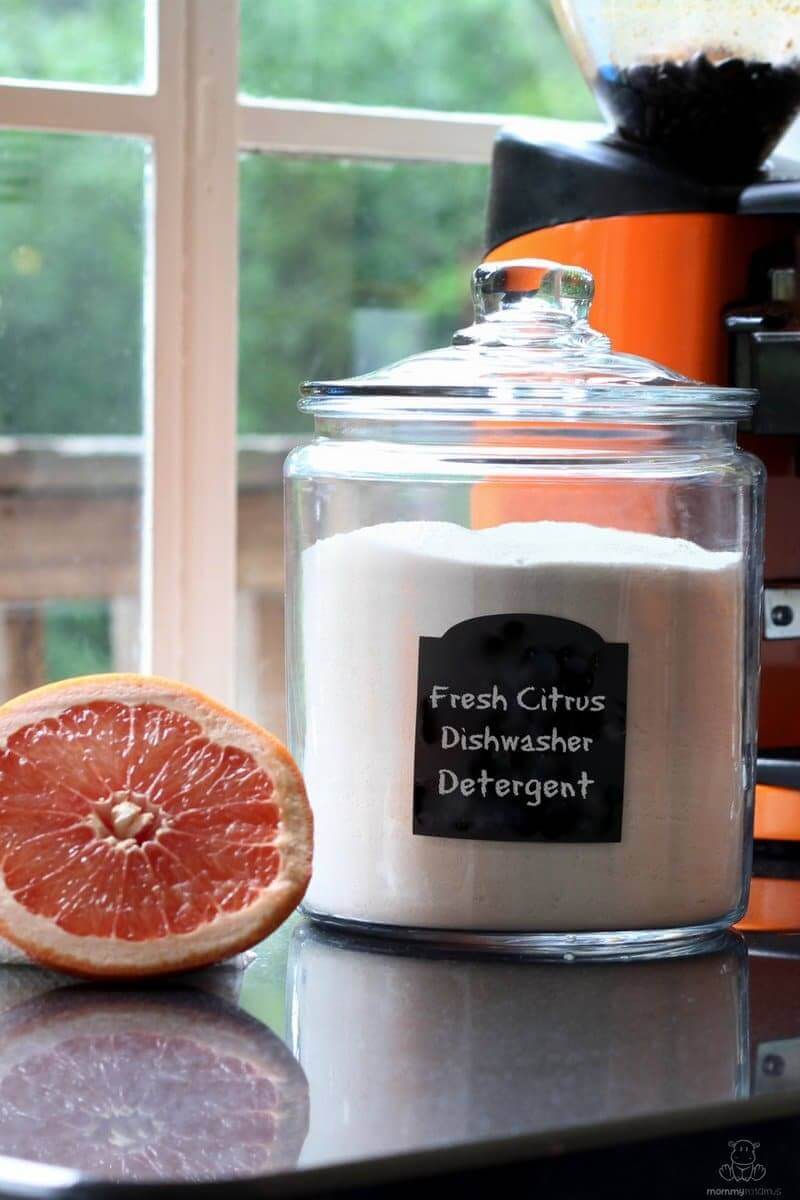
Homemade Dishwasher Detergent Recipe
Equipment
- mason jar (or other airtight container)
- mixing bowl
- spoon
Ingredients
- 4 cups washing soda (If you want to make your own, here's how to make washing soda from baking soda)
- 15-30 drops grapefruit essential oil (optional)
- 5-10 drops lemon essential oil (optional)
Instructions
To Make:
- Combine your ingredients and stir until there are no clumps. Pour into a mason jar or other airtight container and add a clay pouch to absorb moisture if desired. (This is only needed if you find that your dishwasher detergent is clumping. See the FAQ section below for details.)
To Use:
- Use approximately 2 tablespoons per load, or a little more for extra dirty dishes. See notes for details on which compartment to use.
Notes
- My dishwasher has a pre-rinse compartment that releases the first round of powder into the dishwasher. That’s where I put my dishwasher detergent.
- The main detergent compartment pops open later in the cycle – that’s where I put my rinse aid.
 Tried this recipe?
Mention @mommypotamus or tag #mommypotamus!
Tried this recipe?
Mention @mommypotamus or tag #mommypotamus!
Frequently Asked Questions
Add two tablespoons of bentonite clay in a pouch or small sock. This prevents the dishwasher detergent from clumping in high humidity areas. It’s placed in a pouch because it’s not meant to mix with the formula, just absorb excess moisture. However, it’s very rarely necessary. I never use the clay in my home and I have no issues with clumping.
Instead of 4 cups washing soda, use just 2 cups washing soda and add in 2 cups powdered oxygen bleach that contains no fillers – I buy this brand on Amazon. It says it’s 99% pure oxygen bleach (Sodium Percarbonate), but it’s totally pure, non-toxic sodium percarbonate with nothing added. The other 1% is moisture.
This recipe seems to work well even without the rinse aid for some people, but personally I have found it to be essential.
It might be fine, but there’s a possibility that the vinegar could spill out at the same time the washing soda is released, which would neutralize both of their benefits. For that reason I opt not to use this approach.
Make homemade laundry detergent and scouring powder!
Want a FREE ebook of non-toxic cleaning recipes that WORK?
I’ve created a free ebook for you as a gift for signing up for my newsletter. 7 Non-Toxic Cleaning Recipes That Really Work covers seven recipes that you can make in just a few minutes each for squeaky clean windows, sparkling dinnerware, lemon-fresh countertops, and more. Subscribe to my newsletter below and you’ll be redirected to a download page for immediate access to this PDF ebook.

